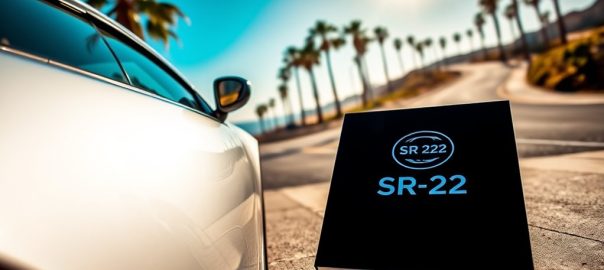Understanding SR-22 insurance in California involves recognizing its purpose, its implications for drivers, and the responsibilities it entails. It serves as a verification of financial responsibility after serious traffic violations, impacting your driving privileges and insurance costs. If you’re maneuvering this requirement, you’ll want to grasp the filing process, associated costs, and the potential consequences of non-compliance. What happens if you let your coverage lapse? The answers could considerably affect your situation.
Key Takeaways
- SR-22 is not insurance but a certificate proving minimum liability coverage required after serious traffic violations in California.
- The SR-22 is typically required for 3 to 5 years and must be maintained without lapses to avoid penalties.
- Filing fees for SR-22 in California range from $15 to $25, but premiums can increase significantly, averaging an additional 187%.
- Continuous coverage is crucial; any lapse can lead to automatic license suspension and reset compliance timelines.
- Shopping around for insurance rates is essential, as premiums can vary significantly among providers after an SR-22 filing.
What Is an SR-22?
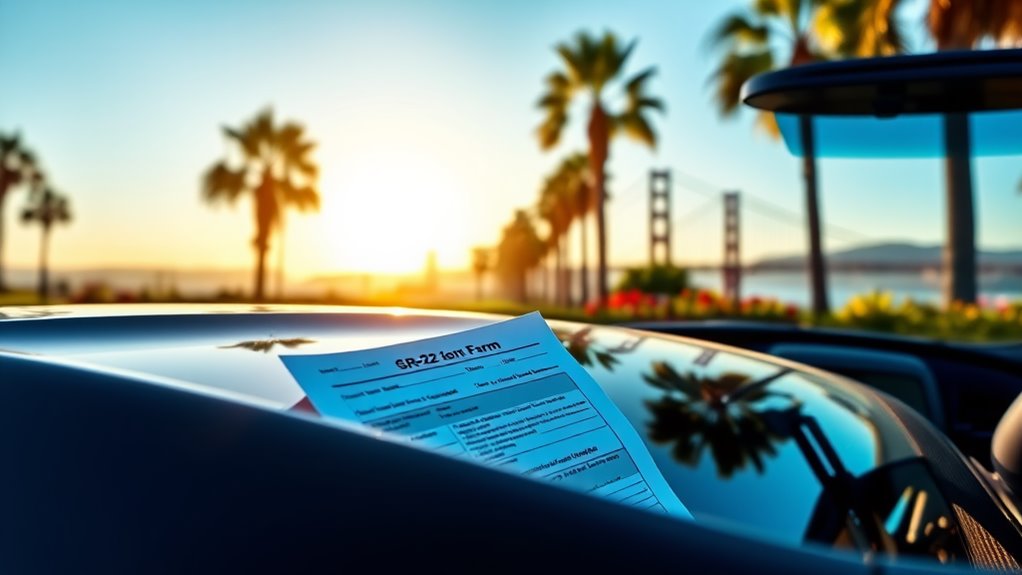
An SR-22 isn’t insurance itself; it’s a state-mandated certificate that proves you have the minimum liability coverage required by California law.
Officially called the Certificate of Financial Responsibility, it guarantees your continuous auto insurance compliance. Your insurer files this certificate with the California DMV, either electronically or via paper form, ensuring that they maintain active reporting of your coverage status throughout the policy term.
The SR-22 is essential for reinstating your driving privileges after a license suspension due to offenses like DUIs or uninsured accidents. It mandates minimum bodily injury coverage of $15,000 per person and $5,000 for property damage, resulting in higher premiums for those labeled as high-risk drivers until the compliance period concludes. Additionally, the SR-22 is required for a specified period, typically 3 years but can extend to 5 years based on driving offenses.
Why Is an SR-22 Required?
When driving privileges are suspended due to serious traffic violations, the state requires an SR-22 to guarantee that drivers can demonstrate financial responsibility moving forward. This requirement typically arises from offenses like DUI convictions, reckless driving, or driving without insurance.
An SR-22 serves as proof of minimum liability coverage, ensuring that you’re financially responsible in case of future incidents. Additionally, if your license is revoked, you’ll need an SR-22 to reinstate it. The duration for which an SR-22 is required can range from three to five years, reflecting the severity of the violations. Maintaining continuous insurance during this period is vital; any lapse could lead to further penalties, including license suspension. Furthermore, it is essential to comply with minimum liability insurance requirements to fulfill the SR-22 stipulation.
The SR-22 Filing Process
When you initiate the SR-22 filing process, your insurance provider takes on the responsibility of preparing and submitting the necessary documentation to the DMV.
It’s vital to understand how renewal notifications work, as failing to stay informed can lead to unexpected lapses in coverage.
Any gap in your insurance can have significant consequences, impacting both your compliance status and financial obligations.
Filing Entity Responsibilities
While maneuvering the SR-22 filing process, insurance providers play an essential role in guaranteeing compliance with California’s regulations. They’re responsible for filing the SR-22 forms with the DMV, confirming that your policy meets the minimum liability requirements:
$15,000 for bodily injury per person,
$30,000 per accident, and
$5,000 for property damage.
Additionally, providers notify you about your filing status and any updates.
Maintaining continuous coverage is critical to guarantee compliance throughout the designated period. Depending on their capabilities, providers can file SR-22 forms electronically or by mail, but timely filing is imperative to avoid complications.
Ultimately, your insurer’s responsibilities considerably influence your ability to reinstate your driving privileges and comply with state laws.
Renewal Notifications Process
To guarantee that you maintain compliance with California’s SR-22 requirements, it’s vital to understand the renewal notifications process.
Typically, your insurance company will send you renewal notifications before your current SR-22 filing expires, allowing a grace period—often 15 days—for renewal actions. These notifications can arrive via mail, email, or phone, depending on your insurer’s practices.
While the DMV doesn’t notify you directly about renewals, timely action is important; failing to renew triggers automatic reports to the DMV about coverage lapses.
Your insurer will file the renewed SR-22 certificate electronically with the DMV, usually taking 3 to 5 business days for verification.
Staying proactive guarantees continuous coverage and compliance with state mandates.
Coverage Lapse Consequences
Maintaining continuous SR-22 coverage is vital, as any lapse can lead to significant consequences for your driving privileges. If your coverage lapses, your insurer is required to notify the DMV within a specified timeframe, potentially resulting in an immediate suspension of your license.
Furthermore, insurers may refuse to renew your policy if they perceive an increased risk due to the lapse, leading to higher premiums when you seek reinstatement. This increase can be steep, especially following a DUI conviction.
To avoid severe penalties, it’s important to guarantee that your insurance remains active throughout the required three-year period. Continuous coverage not only protects your driving rights but also minimizes financial repercussions in the long run.
Costs Associated With SR-22 Insurance
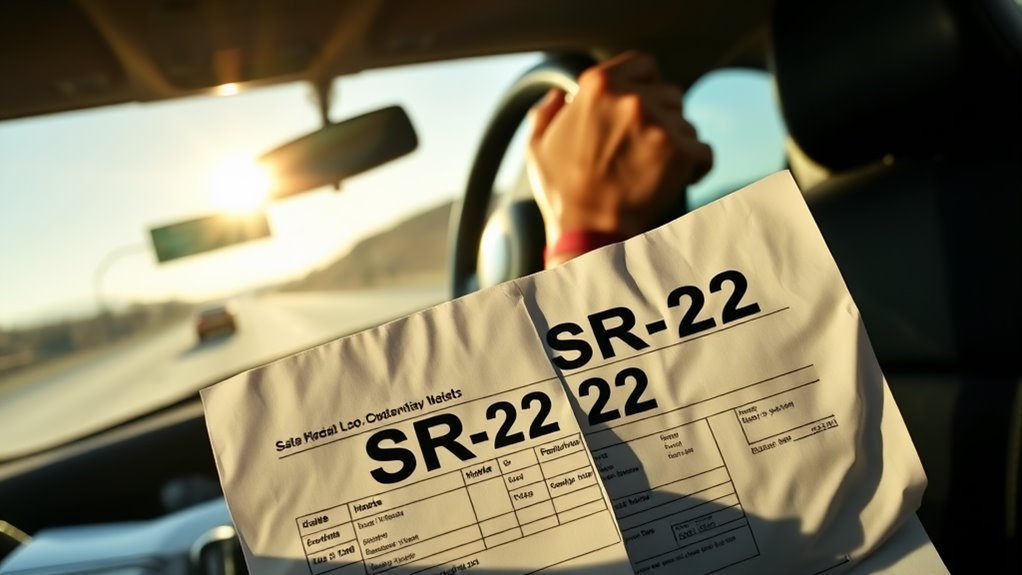
When you look at SR-22 insurance costs, you’ll notice significant premium increases, particularly for those with serious driving violations.
Additionally, filing fees can add to your expenses, typically ranging from $15 to $25 in California.
Understanding the long-term cost implications is essential, as the financial impact of an SR-22 can extend well beyond your initial payment.
Premium Increases Overview
SR-22 insurance often leads to significant premium increases, reflecting the heightened risk perceived by insurers.
In California, you might face an average premium hike of 187% due to the SR-22 requirement, primarily driven by the underlying violation, such as a DUI, rather than the SR-22 itself.
Insurers assess your risk differently after such incidents, resulting in these inflated rates. Compared to other states, California’s hikes are among the highest.
While the average annual cost for full coverage sits at $2,573, a DUI can push that figure to approximately $6,589.
Therefore, understanding the factors influencing these costs is essential for managing your insurance options effectively.
Filing Fees Explained
Understanding the costs associated with SR-22 insurance includes recognizing the filing fees that come into play. In California, these fees typically range from $25 to $40 and are generally one-time charges unless your insurance coverage lapses.
If multiple drivers on the same policy need SR-22s, each will incur a separate fee. Some insurance providers may also add administrative costs, which can vary by company.
While some insurers include the filing fee in overall premiums, others charge it separately. As a result, it’s essential to clarify how your chosen provider handles these charges.
If your insurance lapses, you may have to pay the filing fee again, so maintaining continuous coverage is vital to avoid additional costs.
Long-Term Cost Implications
While managing the costs associated with SR-22 insurance, you’ll quickly notice the significant financial implications that extend far beyond the initial filing fees.
On average, you might pay between $800 and $1,600 annually for SR-22 insurance, with premiums often doubling or tripling compared to standard policies. For instance, DUIs can push your annual premium to around $1,592, while full-coverage averages soar to $3,628.
In California, these costs persist for three years, and any lapse in coverage can trigger additional fees and increased rates. Even after fulfilling SR-22 requirements, your driving record may lead to elevated post-SR-22 rates, affecting your long-term financial obligations.
Therefore, understanding these implications is vital for effective budgeting.
Eligibility for SR-22 Filing
If you’ve committed serious traffic offenses such as DUIs or reckless driving, you may find yourself facing the requirement for SR-22 filing in California.
You’ll need an SR-22 if you’ve been caught driving without insurance, or if multiple traffic violations or license suspensions have occurred. The court typically mandates this requirement, particularly for those with revoked driving privileges.
Offenses like reckless driving and failure to comply with court orders can also trigger the need for SR-22 coverage.
Generally, you’ll be required to maintain this filing for three years, though it can extend up to five years in severe cases.
Your insurance provider files the SR-22 form directly with the DMV, ensuring adherence to California’s minimum liability insurance requirements.
Maintaining Continuous Coverage
Maintaining continuous coverage is vital for anyone required to file an SR-22 in California. You must adhere to the court-ordered duration, typically three years, but it can extend to five years based on the severity of your offense.
California has no grace period for lapses; any gap resets your compliance timeline. Insurers report lapses to the DMV within one to two business days, leading to automatic license suspension and additional costs for re-filing.
Any lapse in coverage in California resets your compliance timeline, leading to automatic license suspension and costly re-filing fees.
Even minor lapses can spike your future premiums. To avoid these issues, set reminders for renewal dates, maintain open communication with your insurer, and guarantee timely payments.
Continuous compliance is essential to prevent legal and financial repercussions.
Legal and Administrative Requirements
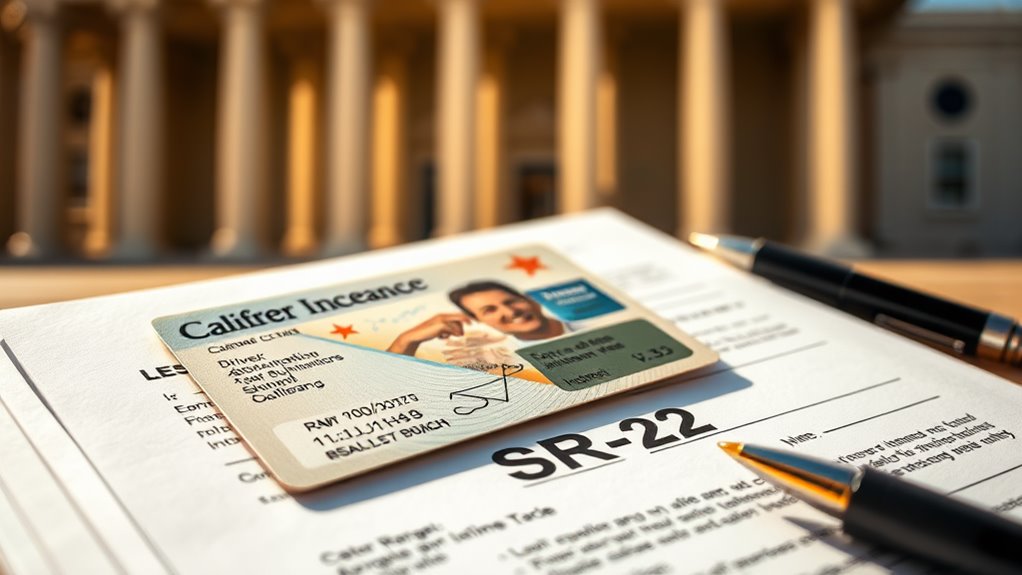
To navigate the legal and administrative landscape of SR-22 insurance in California, you must comply with state laws and follow specific DMV tracking procedures.
Your adherence to court order mandates is essential, as any lapses can result in significant penalties.
Understanding these requirements will help you maintain your driving privileges and avoid complications.
Compliance With State Laws
While complying with state laws regarding SR-22 insurance in California, understanding the legal and administrative requirements is essential for drivers affected by serious traffic offenses.
You must adhere to specific guidelines to maintain compliance, including:
- Minimum Coverage: Carry at least $15,000 for bodily injury per person and $5,000 for property damage.
- Continuous Coverage: Keep your SR-22 insurance active to avoid penalties or license revocation.
- Duration Compliance: Fulfill the SR-22 requirement for three to five years, as mandated by the court.
Failing to follow these regulations can lead to severe consequences, including increased premiums and potential legal issues.
Ensuring you meet all obligations helps protect your driving privileges and financial stability.
DMV Tracking Procedures
Understanding DMV tracking procedures for SR-22 insurance is important for drivers needing to demonstrate compliance with California’s financial responsibility laws.
The DMV requires insurance companies to file the SR-22 form, certifying your minimum liability coverage. They actively monitor these filings to guarantee you maintain continuous coverage, essential after serious traffic violations like a DUI.
If your coverage lapses, the DMV is notified by your insurer and can impose penalties, including license suspension. You can check your insurance status through their automated voice system.
It’s critical to submit proof of insurance promptly and to be aware that the DMV’s tracking guarantees compliance over the mandated period, typically three years.
Court Order Mandates
Court orders often dictate the necessity for SR-22 insurance following serious traffic violations, establishing a legal framework that underscores compliance with California’s financial responsibility laws.
If you’re facing such a mandate, consider these key points:
- SR-22 is required for serious offenses like DUIs, reckless driving, and multiple at-fault accidents.
- Courts may require higher coverage than the state minimum, increasing your financial responsibility.
- Your insurance company must file the SR-22 form with the DMV to confirm compliance.
Navigating this process involves contacting your insurer and possibly incurring additional fees.
It’s essential to understand that not all insurers provide SR-22 coverage, so you may need to shop around to find a suitable option that meets your court-mandated requirements.
Differences in SR-22 Requirements Across States
The variations in SR-22 requirements across states can greatly impact drivers who face mandatory insurance filings. For example, California mandates a minimum coverage of $15,000 per person, while Texas requires $30,000.
Additionally, the offenses triggering an SR-22 differ; in California, DUIs and uninsured driving are common, whereas Texas includes DWIs and repeat violations.
Filing durations also vary considerably; Arkansas can impose 5 to 20 years based on offense severity, while California typically requires three years.
Compliance monitoring is stringent in states like South Dakota, which enforces continuous coverage for three years.
Understanding these differences is essential for drivers traversing the complexities of SR-22 filings across various jurisdictions.
Impact of SR-22 on Insurance Premiums
While many drivers may not realize it, the requirement to file an SR-22 can greatly influence insurance premiums. Here are a few key points to contemplate:
- Filing an SR-22 is linked to high-risk driving behavior.
- Insurance companies assess risk based on your driving history, not the SR-22 itself.
- Rates can vary considerably among different providers.
Due to the SR-22 requirement, you might face higher premiums because insurers view you as a higher risk.
Although the filing itself incurs a small fee, the underlying violations, like DUIs, contribute to considerably increased rates.
In California, average SR-22 insurance costs can reach around $2,403, making it essential to shop around for the best rates to manage your expenses effectively.
Consequences of Non-Compliance With SR-22 Regulations
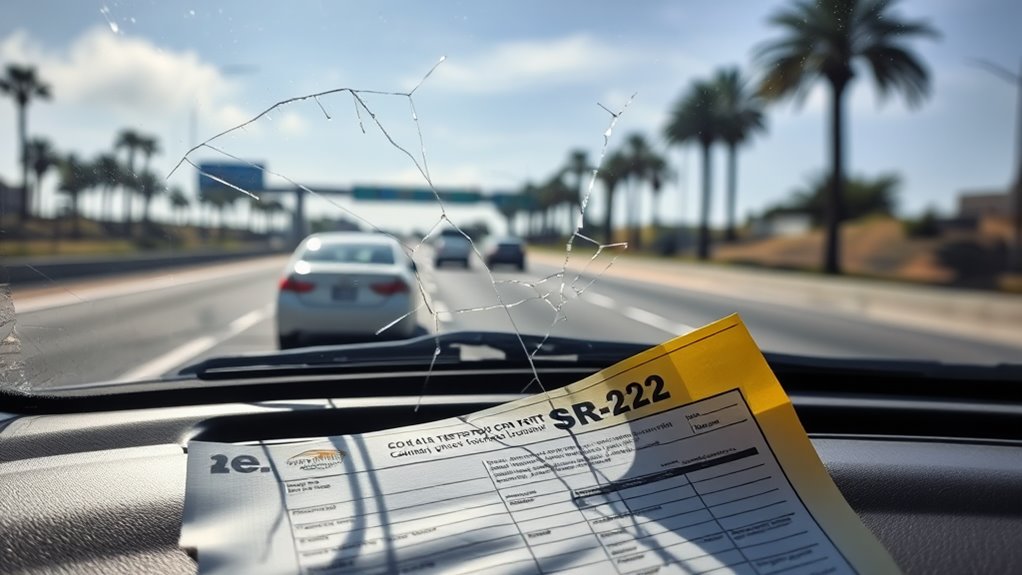
Failing to comply with SR-22 regulations can lead to severe repercussions that extend beyond just increased insurance rates. Your license may face automatic suspension, lasting up to four years for certain violations.
If your SR-22 lapses, you risk losing restricted license options and may face difficulties in getting your license reinstated. Financially, you’ll encounter reinstatement fees, additional fines, and potential legal costs if court proceedings arise.
Vehicle registration could be jeopardized, with holds placed on your vehicle during suspension periods. Additionally, non-compliance can result in legal ramifications, including contempt charges or misdemeanor penalties.
Long-term consequences include being classified as a high-risk driver and facing challenges in employment opportunities that require a valid driver’s license.
Frequently Asked Questions
How Long Does the SR-22 Remain on My Record?
The SR-22 typically remains on your driving record for three years, but it can vary based on the offense. More serious violations might extend this duration, so it’s crucial to understand your specific situation.
Can I Switch Insurance Companies While Having an SR-22?
Yes, you can switch insurance companies while having an SR-22. Just guarantee there’s no lapse in coverage, inform your new provider about the SR-22 requirement, and let them handle the necessary paperwork with the DMV.
What Happens if I Move Out of California With an SR-22?
If you move out of California with an SR-22, you’ll still need to maintain compliance with both states’ requirements. Notify both DMVs and guarantee continuous coverage to avoid legal complications and potential penalties.
Can I Drive Other Vehicles With an SR-22?
You can absolutely drive other vehicles with an SR-22, as long as you have the proper non-owner policy. This coverage protects you in case of accidents, ensuring you’re compliant with state insurance requirements.
Will an SR-22 Affect My Job Opportunities?
An SR-22 can complicate job opportunities, especially in driving-related roles. Employers might see you as a higher liability, impacting your job prospects, compliance with requirements, and overall employment stability due to associated financial burdens.
Conclusion
Maneuvering SR-22 insurance in California is like steering through a complex maze; one misstep can lead to serious consequences. By understanding the requirements and maintaining continuous coverage, you can keep your driving privileges intact and avoid steep penalties. Remember, the SR-22 isn’t just a formality—it’s a critical aspect of your financial responsibility as a driver. Stay informed and compliant to guarantee a smoother road ahead in your driving journey.
